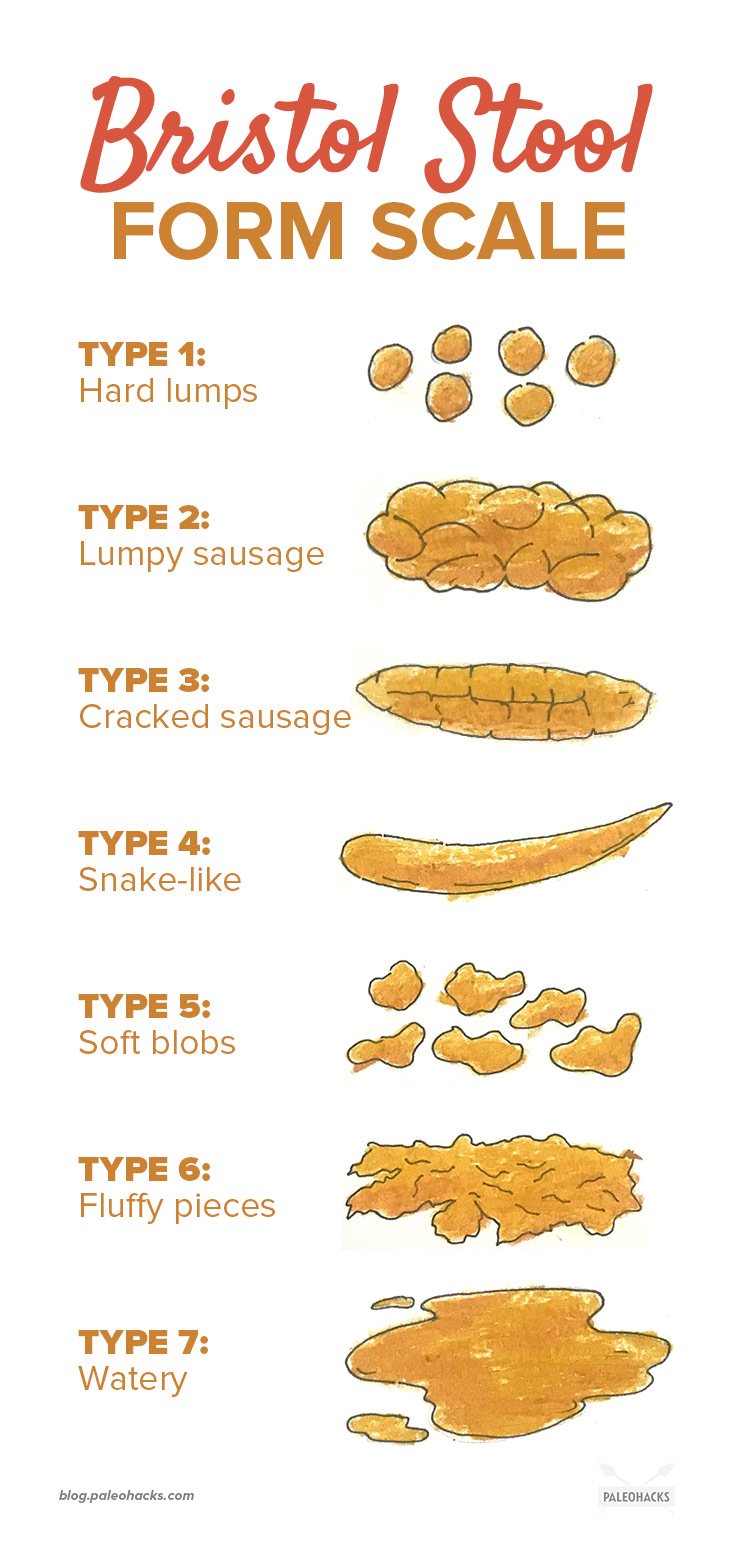With all the buzz around gut health, you might be curious about whether your own digestive system is normal.
Could you have leaky gut? Just what should your stools look like?
While these aren’t exactly dinner conversation topics, being able to analyze and identify gut issues starts by examining your own bowel movements – and often. Being able to talk about them, especially with your doctor, can mean dramatically positive things for your health.
Do you struggle with bloating, gas, constipation, or other digestive issues? We’ve created a FREE guide to healing your gut naturally.
Click here to get your FREE copy of our Digestion Guide!
Gut Health vs Total Health

The gut gets a lot of focus because it’s literally the seat of wellness. We are only as healthy as our ability to digest and eliminate the food that we eat. Gut health influences the way we absorb nutrients from our food, as well as our risk of chronic disease and food sensitivities/allergies, our immunity, mental health, mood, and even body weight. (1,2,3)
Understanding how bowel health is related to total health can give you a step up in being proactive about your well-being. To start, it’s important to know the function of your digestive system. Many people only consider the stomach in regards to digestion, but the majority of food is actually broken down and absorbed in the small intestine. If the large intestine can’t properly eliminate what has been digested, gut health will be compromised.
Some specific gut conditions include:
- Leaky Gut
- SIBO (small intestinal bacterial overgrowth)
- Parasites
- H. Pylori
- Macronutrient digestion problems
- Crohn’s disease
- Ulcerative colitis
- Diverticulitis
- Celiac disease
7 Ways to Self-Test Your Gut Health
If you think you have any of these gut problems, it’s imperative to see a doctor immediately. If left untreated, these conditions can cause other health problems and wreak havoc on a person’s body.
Even if you don’t have any of these known conditions, you might simply want to know if your gut is super healthy or needs a little TLC. Luckily, there are some easy ways to do a basic self-assessment in the comfort of your own home.
If you “fail” any of these self-tests or have concerns beyond what you can learn, ask your doctor to test your gut using the easy, fast microbiome kit from ubiome, which can help to pinpoint problems and give an overall snapshot of gut health.
1. Bristol Stool Form Scale
Researchers at the University of Bristol wanted a way to classify stools as a way to identify potential bowel disorders. They created the Bristol Stool Form Scale, which breaks down bowel movements into seven different categories, along with category names that help to identify what the related issues might be.
The Bristol chart can help to identify transit issues because the longer it takes for bowels to eliminate, the harder and drier the stool becomes. If it has fast exit times, it will be loose and watery, perhaps even as diarrhea.
If you look at the chart and compare your stools to it, you can learn a lot about what your gut might be telling you (4,5,6).
Type 1: Hard lumps
Could Mean: Constipation, too little fiber (sometimes seen in keto eaters who eat very low-carb), poor gut bacteria, recent antibiotic exposure
Type 2: Lumpy sausage
Could Mean: IBS, chronic constipation, anal fissures, and hemorrhoids
Type 3: Cracked sausage
Normal for some people, or could signify slight constipation
Type 4: Snake-like
Ideal and healthy
Type 5: Soft blobs
Normal for 2-3 bowel movements daily, or can potentially indicate incomplete digestion or microbiome imbalances
Type 6: Fluffy pieces
Could Mean: Stress, laxative use or abuse, gut disorders, or microbiome imbalance
Type 7: Watery
Could Mean: Diarrhea, food allergy/sensitivity/intolerance, Celiac exposure, foodborne illness, Crohn’s disease, or other extreme gut irritants
If you compare your stools to the Bristol chart for a week and find that they often are mirroring types 1, 2, 6, or 7, you may want to speak to your practitioner to get clinical stool testing to see if there’s a larger issue at play.
2. Symptom Spotting
Taking note of any potential symptoms of gut disorders is a helpful way to pinpoint issues, especially when used in conjunction with some of these other self-test methods. The following symptoms are often associated with dysfunctional digestion or compromised gut health in one way or another, and may warrant further investigation:
- Regular gas, bloating and belching after meals
- Frequent loose stools or diarrhea
- Bad breath that you can’t brush away
- Mucus in the stool
- Indigestion, reflux, or heartburn
- Regular undigested food particles in bowel movements
- Alternating constipation and diarrhea
- Problems passing bowel movements, like pain or straining
- Stabbing intestinal pains that frequently occur
While these symptoms can all be normal individually at one time or another, if any of them are a regular occurrence, they indicate that something is off-balance within the digestive tract (7).
3. Transit Time
The Transit Time test refers to how long food takes to go from your mouth to be fully broken down during digestion and then eliminated from the intestines. Basically, how long does it take from that first bite to your daily poop?
Transit time can vary based on a number of factors but, in general, it is ideally 12-48 hours. The Transit Time test can help to identify true constipation, excessively rapid transit times, and other microbiome imbalances. (8,9)
While doctors can test transit time by using capsules filled with markers that are visible on X-ray or certain types of dye, it can be just as effective to test transit time at home using one of the following:
- Red beets – 1 full cup, boiled and mashed, or raw and shredded, eaten 4 hours away from any other food.
- Sesame seeds – 1 tbsp mixed into 1 cup of water and swallowed whole.
After you consume your testing food of choice, write down the time and date that you ate it. From there, all you have to do is check your bowel movements each time and note when you see signs of the test food appearing. Beets will give stool a purple, magenta, or maroon color, and sesame seeds will show up fully intact, making it easy to spot. (Note: beets can also cause urine to turn a pinkish-red color briefly so if that occurs, don’t be alarmed).
As mentioned above, you’ll be hoping to see your test food reappear after 12 to 48 hours. If it takes 72 hours or longer, that would be indicative of constipation, toxicity, SIBO, pathogenic infections, and microbiome imbalance. (10) If it shows up sooner than 12 hours, then it’s indicative of another sort of digestive imbalance, including potential food intolerance or sensitivity, nutrient deficiencies, or irritable bowel disease. (11)
Because numerous factors can influence gut transit time (like fiber, hydration, activity level, caffeine, and alcohol intake), this isn’t a one and done self-test. It’s best to repeat this test three to five times over the course of a week or two, done at different times of the day. Don’t start a repeat test until you’re sure that everything from the previous one has been eliminated and noted on your results chart.
4. Frequency of Elimination
While this can be addressed using the Transit Time test, this is a simpler version. There is no set number that can single-handedly determine if the elimination frequency is healthy, but most doctors won’t be concerned if you go anywhere from three times per day to three times per week, unless other digestive symptoms or pain is present. Pair this self-test with others to help determine what your normal elimination is, and whether that is optimal for you. [tweet_quote]For people who eliminate less than once per day, the answer might be as simple as adding more fiber and vegetables to the diet.[/tweet_quote]
For people who eliminate less than once per day, the answer might be as simple as adding more fiber and vegetables to the diet. Most people, if asked, will state that they feel best when they are able to go at least once per day. This cuts down on bloating and intestinal discomfort.
If it’s difficult to keep track of how and when you’re going, it’s time to start an elimination journal. This can be done as simply as keeping a note on your smartphone or making notes in a notebook. You should make note of the time, size, color, and texture. If, after two to three weeks, you see a pattern that doesn’t seem normal for you or would be flagged by any of these self-tests, then it’s time to ask your doctor.
5. Odor Inspection
Sure, this seems odd, as most bowel movements don’t smell pleasant. However, it’s time to take note if your poop is especially smelly (or your gas, for that matter). If the smell reminds you of rotten eggs, sulfur, or rotting meat, this could be a sign of malabsorption, fermentation in the gut, SIBO, or even parasites. (12,13)
A once in a while worse-than-usual smelling stool is okay, but it’s developing a regular pattern of having extremely foul-smelling stools that needs to be addressed by a medical professional.
6. Visual Inspection
This one is pretty self-explanatory and is closely related to the Bristol Stool Scale. Visual inspection is faster and easier since you’re only looking for two culprits:
- Floaters
- Undigested particles
Does your poop sink to the bottom of the toilet bowl, or float to the top? Frequent floaters can sometimes be a sign of gas, incomplete digestion, gallbladder issues, pancreas disorders, lactose intolerance, or other similar issues. (14,15) With no other symptoms, floating stool alone isn’t a sign for concern. However, if you’re seeing your doctor for other reasons, it wouldn’t hurt to mention, especially if it is regularly occurring.
Undigested particles in bowel movements are a more straightforward sign of incomplete digestion. Literally, the food isn’t being fully broken down, which is why it still shows as recognizable food in your toilet bowl. When this happens, it can be a result of many things, including: (16,17,18)
- Poor chewing habits
- Drinking too much liquid during meals
- Eating too fast
- Eating too many tough textured foods like seeds and nuts
- Low digestive enzymes
- Low stomach acid
- Inflammation in the small or large intestine associated with IBD
If you regularly see undigested food in your stool, it’s definitely important to mention it to your practitioner.
7. Color Inspection
Related to visual inspection, this categorizes your stool based on color. While the Bristol scale will help with texture and shape, color can also indicate aspects of gut health.

Brown is the most common color and is ideal. However, there are varying shades of brown, and even that can get confusing.
Medium brown is ideal. Lighter brown could indicate the presence of mucus within the stool, and extremely dark brown can be indicative of constipation. Black stool is a serious concern as that usually indicates blood. White stool, likewise, is a very serious concern too, as it can indicate severe malabsorption or digestive dysfunction. Pale, gray, or clay-colored stools can indicate low iron or other nutrient issues. Green stool can also show signs of a dairy allergy or other food intolerances or sensitivity.
Keep in mind that certain foods, medications, and supplements can change stool color, so it’s important to keep a food diary if you’re going to regularly assess the color of your stool. A diet high in leafy greens can produce darker or even greenish stools; beets can make stools red or purple, along with purple cabbage; turmeric and carrots can produce more orange-looking poop; iron supplements or high-iron intake can produce very dark stools.
Again, these self-test methods are best used in conjunction with each other, and at the sign of anything that warrants concern – or even just on a gut feeling that something is off – it’s always best to check with a doctor and, if necessary, get clinical stool testing.
(Read This Next: 5 Ways to Heal Your Gut After Taking Antibiotics)




 Creamy + Low Carb Keto Cacao Milkshake
Creamy + Low Carb Keto Cacao Milkshake








Show Comments